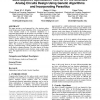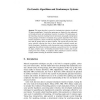12 search results - page 1 / 3 » Implicit fitness and heterogeneous preferences in the geneti... |
GECCO
2010
Springer
13 years 4 months ago
2010
Springer
This paper takes an economic approach to derive an evolutionary learning model based entirely on the endogenous employment of genetic operators in the service of self-interested a...
ICIP
2009
IEEE
13 years 2 months ago
2009
IEEE
Supershape model is a recent primitive that represents numerous 3D shapes with several symmetry axes. The main interest of this model is its capability to reconstruct more complex...
GECCO
2007
Springer
13 years 10 months ago
2007
Springer
In many design tasks it is difficult to explicitly define an objective function. This paper uses machine learning to derive an objective in a feature space based on selected examp...
GECCO
2007
Springer
13 years 8 months ago
2007
Springer
This paper presents a novel approach for a free structure analog circuit design using Genetic Algorithms (GA). A major problem in a free structure circuit is its sensitivity calcu...
PPSN
1998
Springer
13 years 8 months ago
1998
Springer
This paper describes a system for simulating the evolution of artificial 2D plant morphologies. Virtual plant genotypes are inspired by the mathematical formalism known as Lindenma...



